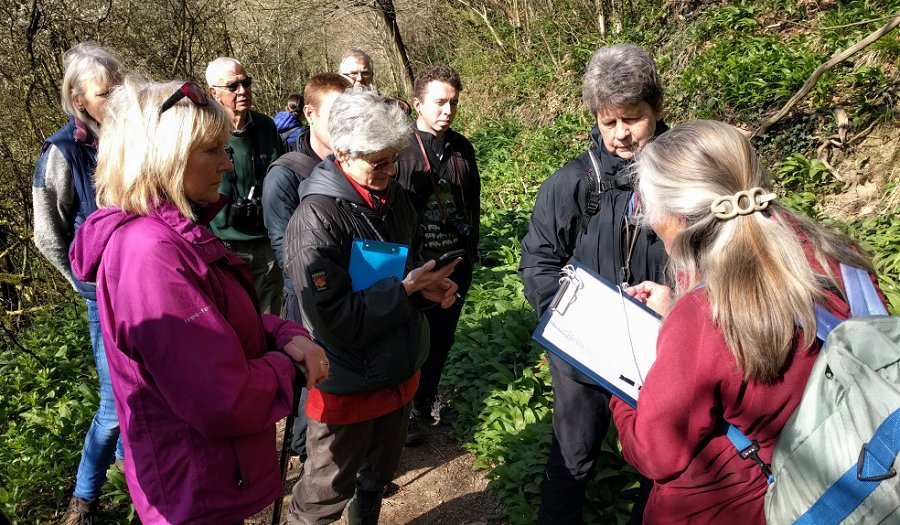

On a lovely sunny day (though with a cold easterly wind) 16 members and friends – including two children which was fantastic – gathered for a meeting that was primarily to see the spring wildflowers. After a brief diversion to see the long-established garden escape Abraham, Isaac and Jacob on the roadside, Gill led the party along the flank of Ashberry Wood from the farmstead, down across the water meadows to Bow Bridge, then returned through waterside meadows to Rievaulx village, returning along the road passing the Abbey on the way.
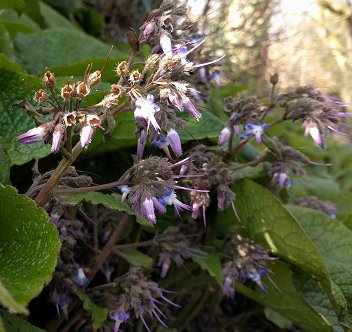 Abraham, Isaac and Jacob | 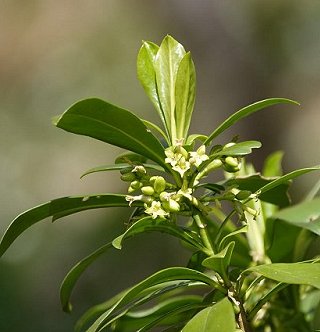 Spurge laurel |
Ashberry Wood is a surviving patch of ancient woodland on limestone, and has a particularly rich flora. We saw two of the local specialities just inside the gate: green hellebore and spurge laurel – which is in fact a Daphne species, and a little further along the mountain currant. We discussed the differences between the early or wood dog violet and its very similar relative common dog violet and enjoyed the primroses and wood anemones amongst many other flowers. We recorded over 120 species (several of them in leaf only - many thanks to Melanie for id’ing most of these. There are a good number of plants that were not yet showing, for instance baneberry which is known to be in these woods, so this is a conservative estimate of the total number of species present. We saw a group of at least 9 fallow deer in the wood.
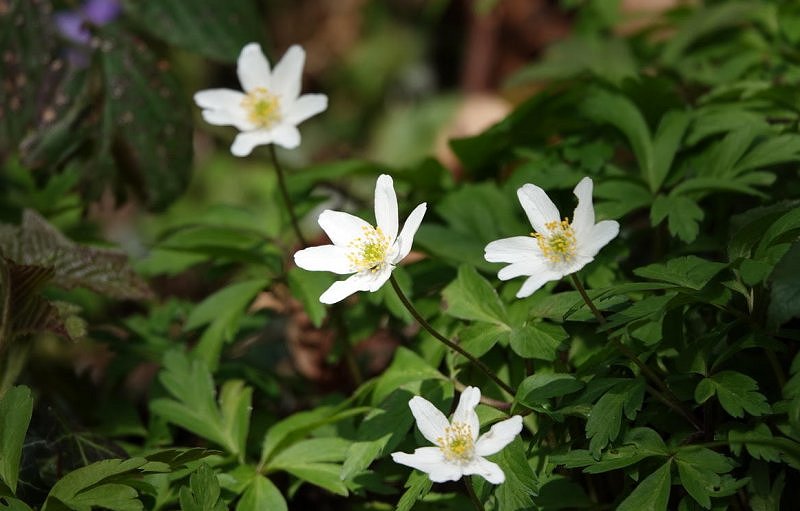
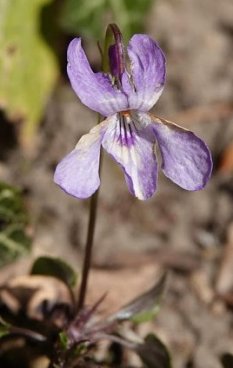 Wood dog violet |
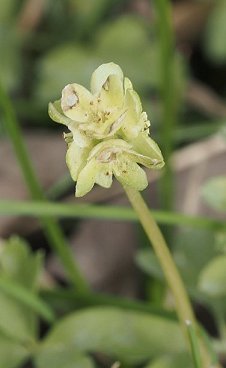 Town Hall Clock or Moschatel |
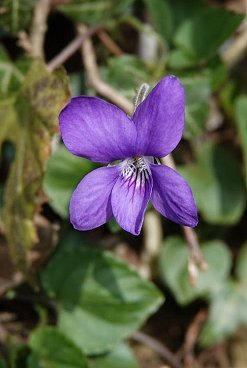 Common dog violet |
The meadows along the riverside did not show such a variety of plants but made for a very pleasant walk back towards Rievaulx, and provided some splendid views of the Abbey ruins.
We saw or heard a good number of birds, and were able to watch a nuthatch entering a prospective nest hole – we think this was the female as the other bird, the male, was calling loudly from a nearby tree (below).
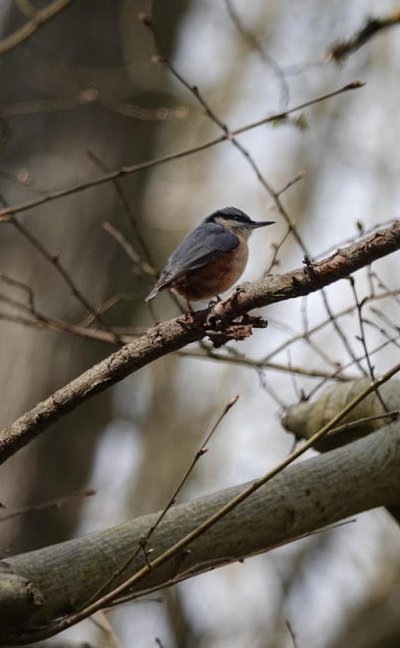
| 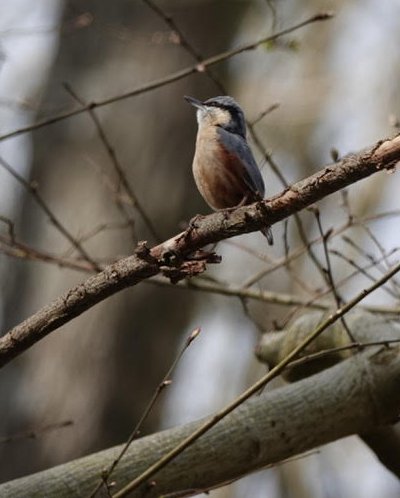
|
There were not many insects about presumably as the air was so cold. We did see peacock and small tortoisesehll butterflies, a 7-spot ladybird, a buff-tailed bumblebee, an Andrena mining bee, a St. Mark’s fly and in interesting beetle – the Red-breasted carrion beetle Oiceoptoma thoracicum (thanks Jordan for the id). According to info on the web it is found on or under the carcasses of birds and small mammals, often in woodland habitats, and curiously enough this species does not eat the material itself, but both adults and larvae hunt for larvae of other insects, such as flies, eating from the remains.
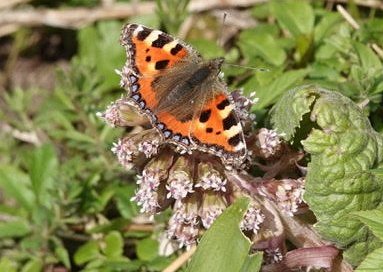 | 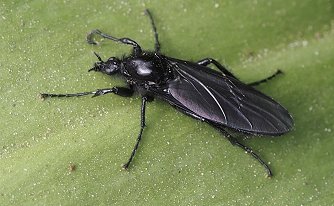 Small tortoiseshell and St. Mark’s fly |
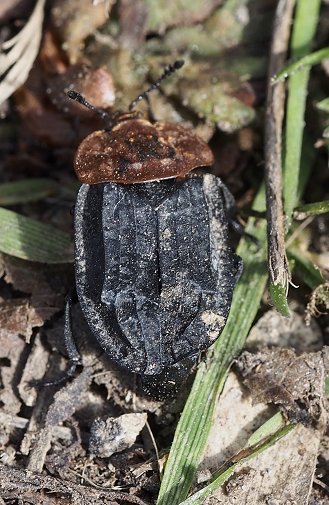
Red-breasted carrion beetle Oiceoptoma thoracicum
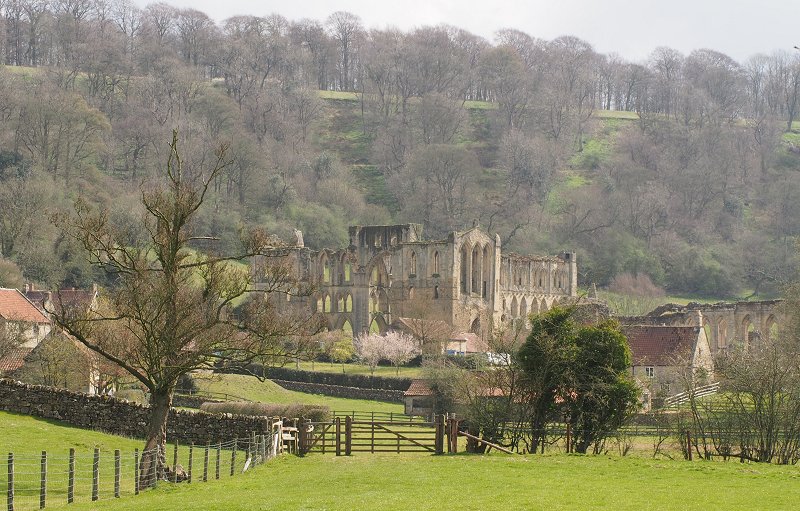
| Latin name | Common name |
|---|---|
| Acer campestre | Field maple |
| Achillea millefolium | Yarrow |
| Adoxa moschatellina | Moschatel |
| Aegopodium podagraria | Ground elder |
| Ajuga reptans | Bugle |
| Alliaria petiolata | Hedge garlic or Garlic mustard |
| Allium ursinum | Ramsons |
| Alnus glutinosa | Alder |
| Anemone nemorosa | Wood anemone |
| Anthriscus sylvestris | Cow parsley |
| Arabidopsis thaliana | Thale cress |
| Arctium minus | Burdock |
| Arum maculatum | Cuckoo pint |
| Bellis perennis | Daisy |
| Betula sp. | Birch |
| Brachypodium sylvaticum | Slender false brome |
| Caltha palustris | Marsh marigold |
| Capsella bursa-pastoris | Shepherd's purse |
| Cardamine flexuosa | Wavy bittercress |
| Cardamine hirsuta | Hairy bittercress |
| Carex flacca | Glaucous sedge |
| Carex sylvatica | Wood sedge |
| Centaurea nigra | Common knapweed |
| Cerastium fontanum | Common mouse-ear |
| Chelidonium majus | Greater celandine |
| Chrysosplenium oppositifolium | Opposite-leaved golden saxifrage |
| Cirsium arvense | Creeping thistle |
| Cirsium palustre | Marsh thistle |
| Cirsium vulgare | Spear thistle |
| Conopodium majus | Pignut |
| Corylus avellana | Hazel |
| Crataegus monogyna | Hawthorn |
| Cruciata laevipes | Crosswort |
| Cymbalaria muralis | Ivy-leaved toadflax |
| Dactylis glomerata | Cocksfoot |
| Daphne laureola | Spurge laurel |
| Deschampsia caespitosa | Tufted hair grass |
| Dryopteris affinis | Golden-scaled male fern |
| Dryopteris dilatata | Common buckler fern |
| Dryopteris filix-mas | Male fern |
| Filipendula ulmaria | Meadowsweet |
| Fragaria vesca | Wild strawberry |
| Fraxinus excelsior | Ash |
| Galium aparine | Cleavers |
| Galium odoratum | Woodruff |
| Geranium dissectum | Cut-leaved cranesbill |
| Geranium pratense | Meadow cranesbill |
| Geranium robertianum | Herb Robert |
| Geum urbanum | Wood avens |
| Glechoma hederacea | Ground ivy |
| Glyceria sp. | Flote grass |
| Hedera helix | Ivy |
| Helleborus viridis | Green hellebore |
| Heracleum sphondylium | Hogweed |
| Holcus mollis | Creeping soft grass |
| Hyacinthoides non-scripta | Bluebell |
| Hypericum hirsutum | Hairy St Johnswort |
| Ilex aquifolium | Holly |
| Juncus effusus | Soft rush |
| Juncus inflexus | Hard rush |
| Lamium album | White dead nettle |
| Lamium purpureum | Red dead nettle |
| Lapsana communis | Nipplewort |
| Lathrea squamaria | Toothwort |
| Lathyrus pratensis | Meadow vetchling |
| Lolium perenne | Perennial rye grass |
| Lonicera periclymenum | Honeysuckle |
| Luzula campestris | Field woodrush |
| Luzula sylvatica | Greater woodrush |
| Lysimachia nemorum | Yellow pimpernel |
| Mercurialis perennis | Dog's mercury |
| Mycelis muralis | Wall lettuce |
| Myosotis arvensis | Field forgetmenot |
| Myosotis sylvatica | Wood forgetmenot |
| Myrrhis odorata | Sweet cicely |
| Oxalis acetosella | Wood sorrel |
| Petasites hybridus | Butterbur |
| Pilosella officinarum | Mouse-ear hawkweed |
| Plantago lanceolata | Ribwort plantain |
| Plantago major | Ratstail plantain |
| Poa annua | Annual meadow grass |
| Polystichum aculeatum | Hard shield fern |
| Potentilla reptans | Creeping cinquefoil |
| Potentilla sterilis | Barren strawberry |
| Primula vulgaris | Primrose |
| Prunella vulgaris | Self heal |
| Prunus avium | Wild cherry |
| Prunus spinosa | Blackthorn |
| Pteridium aquilinum | Bracken |
| Quercus sp. | Oak |
| Ranunculus acris | Meadow buttercup |
| Ranunculus ficaria = Ficaria verna ssp fertilis | Lesser celandine |
| Ranunculus repens | Creeping buttercup |
| Ribes alpinum | Mountain currant |
| Ribes uva-crispa | Gooseberry |
| Rorippa microphylla = Nasturtium microphyllum | Narrow-fruited watercress |
| Rosa sp. | Rose |
| Rubus fruticosus | Bramble |
| Rumex obtusifolius | Broad-leaved dock |
| Salix caprea | Goat willow |
| Sambucus nigra | Elder |
| Scrophularia auriculata | Water figwort |
| Scrophularia nodosa | Common figwort |
| Senecio vulgaris | Common groundsel |
| Silene dioica | Red campion |
| Sonchus oleraceus | Smooth sowthistle |
| Stachys sylvatica | Hedge woundwort |
| Stellaria holostea | Greater stitchwort |
| Stellaria media | Chickweed |
| Taraxacum sp. | Dandelion |
| Teucrium scorodonia | Wood sage |
| Trachystemon orientalis | Abraham Isaac and Jacob |
| Trifolium repens | White clover |
| Urtica dioica | Nettle |
| Veronica agrestis | Green field speedwell |
| Veronica beccabunga | Brooklime |
| Veronica chamaedrys | Germander speedwell |
| Veronica filiformis | Slender speedwell |
| Veronica hederifolia | Ivy-leaved speedwell |
| Veronica persica | Common field speedwell |
| Vicia sepium | Bush vetch |
| Viola odorata | Sweet violet |
| Viola reichenbachiana | Early dog violet |
| Viola riviniana | Dog violet |
Great Tit
Blue Tit
Long-tailed Tit
Marsh Tit
Coal Tit
Nuthatch
Greenfinch
Goldfinch
Siskin
Blackbird
Wren
Grey Wagtail
Chiffchaff
Wood Pigeon
Jackdaw
Buzzard
Rook
Fallow deer
Bee Fly
Small Tortoiseshell
Mining bee Andrena sp.
Honeybee
Bumblebee Bombus sp.
Peacock butterfly
Shield Bug
Red-breasted carrion beetle
7-spot ladybird
Thanks to Keith and Tom for the bird and insect lists
| © Ryedale Natural History Society 2019, Photos © Keith Gittens, Nick Fraser, Jordan Protano-Byrne 2019 |